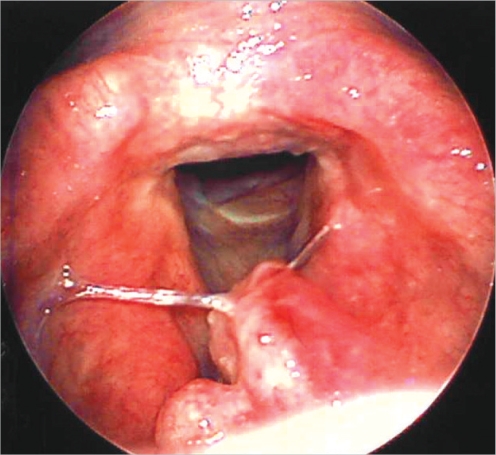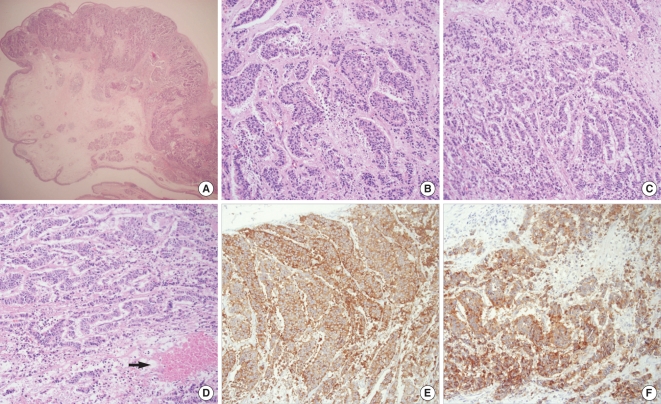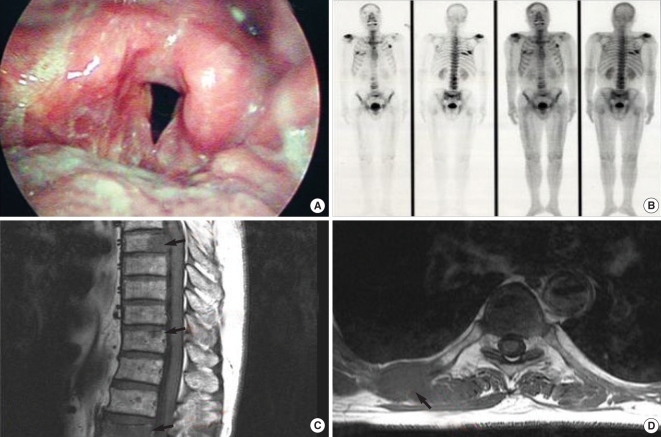Clin Exp Otorhinolaryngol.
2008 Dec;1(4):217-220.
Moderately Differentiated Neuroendocrine Carcinoma of the Larynx
- Affiliations
-
- 1Department of Otorhinolaryngology-Head and Neck Surgery, Korea University College of Medicine, Seoul, Korea. kyjung@kumc.or.kr
Abstract
- Neuroendocrine neoplasm of the larynx is a morphologically heterogeneous group of tumors. This unusual neoplasm includes the four different type of tumors. Paraganglioma is the best-known neural origin tumor. The epithelial origin tumor is further divided based on the degree of differentiation into well, moderately, and poorly differentiated carcinoma. The diverse biological behavior of neuroendocrine neoplasm of larynx makes an accurate diagnosis of paramount importance, since treatment depends on diagnostic accuracy. The diagnosis is based primarily on light microscopy, and immunohistochemical and/or ultrastructural investigations are needed to diagnose correctly. The mainstay of treatment of moderately differentiated neuroendocrine carcinoma of the larynx is surgery. Elective neck treatment should be performed considering the high likelihood of cervical lymph node metastases. The 5-yr survival rate approximates 50%, and 10-yr survival rate is only 30%.
Keyword
MeSH Terms
Figure
Reference
-
1. Goldman NC, Hood CI, Singleton GT. Carcinoid of the larynx. Arch Otolaryngol. 1969; 7. 90(1):64–67. PMID: 5785991.
Article2. McBride LC, Righi PD, Krakovitz PR. Case study of well-differentiated carcinoid tumor of the larynx and review of laryngeal neuroendocrine tumors. Otolaryngol Head Neck Surg. 1999; 4. 120(4):536–539. PMID: 10187951.
Article3. Ferlito A, Barnes L, Rinaldo A, Gnepp DR, Milroy CM. A review of neuroendocrine neoplasms of the larynx: update on diagnosis and treatment. J Laryngol Otol. 1998; 9. 112(9):827–834. PMID: 9876371.
Article4. Hauser H, Wolf G, Uranus S, Klimpfinger M. Neuroendocrine tumors in various organ systems in a ten-year period. Eur J Surg Oncol. 1995; 6. 21(3):297–300. PMID: 7781801.5. Gillenwater A, Lewin J, Roberts D, El-Naggar A. Moderately differentiated neuroendocrine carcinoma (atypical carcinoid) of the larynx: a clinically aggressive tumor. Laryngoscope. 2005; 7. 115(7):1191–1195. PMID: 15995505.
Article6. Ferlito A, Rinaldo A. The spectrum of endocrinocarcinomas of the larynx. Oral Oncol. 2005; 10. 41(9):878–883. PMID: 16154516.
Article7. Chung JH, Lee SS, Shim YS, Kim SY, Nam SY, Kim DH, et al. A study of moderately differentiated neuroendocrine carcinomas of the larynx and an examination of non-neoplastic larynx tissue for neuroendocrine cells. Laryngoscope. 2004; 7. 114(7):1264–1270. PMID: 15235358.
Article8. Ferlito A, Shaha AR, Rinaldo A. Neuroendocrine neoplasms of the larynx: diagnosis, treatment and prognosis. ORL J Otorhinolaryngol Relat Spec. 2002; Mar–Apr. 64(2):108–113. PMID: 12021501.
Article





